 |
 |
 |
| |
Probability of virologic relapse during follow-up varies with the rapidity of the on-treatment virologic response in HCV genotype 1 patients treated with peginterferon alfa-2a (40KD) and ribavirin
|
| |
| |
Reported by Jules Levin
AASLD Nov 4 2008 San Francisco, CA
M.L. Shiffman,1 M.W. Fried,2 S.J. Hadziyannis,3 D. Messinger,4 P. Ferenci5
1Virginia Commonwealth University Medical Center, Richmond, VA, USA; 2Dept. of Medicine/Liver Program, Univ. of North Carolina at Chapel Hill, Chapel Hill, NC, USA;
3Department of Medicine and Hepatology, Henry Dunant Hospital, Athens, Greece. 4Biometrics, IST GmbH, Mannheim, Germany. 5Internal Medicine III, Medical University of Vienna, Wien, Austria
Introduction
For chronic hepatitis C patients treated with pegylated interferon plus ribavirin, it is well established that on-treatment virologic responses are a good predictor of achieving a sustained virologic response (SVR). Among patients of all genotypes, SVR rates are highest in those who achieve a rapid virologic response (RVR) which is defined as HCV RNA <50 IU/mL by week 4.[1,2] Achieving a complete early virologic response (cEVR; HCV RNA >50 IU/mL at week 4 but <50 IU/mL by week 12) is also associated with high rates of SVR.[3] Conversely, slow responders who only become HCV RNA-undetectable beyond week 12 of treatment, tend to have lower rates of SVR with standard treatment durations.[3]
If delayed virologic response is associated with increased rates of virologic relapse after treatment is stopped, it may be possible to maximize SVR rates in slow responders by employing treatment strategies to reduce relapse (e.g. maximizing ribavirin exposure and extending treatment duration).
AUTHOR CONCLUSIONS
These data clearly demonstrate a correlation between the time taken to achieve a negative HCV RNA and the probability of relapse occurring in genotype 1 patients who achieved a 48 week EOT response. There is an inverse relationship between SVR rates and relapse rates. Patients who achieved an RVR at week 4 exhibited the lowest rates of relapse at only 4% whereas those who were 'slow to respond'or did not achieve an EVR had much higher relapse rates of 56% and 62% respectively.
Based on the results of this analysis, patients with slower responses to treatment may benefit from generic strategies to reduce relapse, such as higher doses of ribavirin[6] and extension of treatment duration,[7] with the ultimate goal of maximizing SVR rates.
The present analysis is limited by relatively infrequent on-treatment sampling for HCV RNA (week 4, 12 and 24). More frequent monitoring of HCV RNA may allow a more precise evaluation of the time to achieving a negative HCV RNA and the possibility of selecting a flexible treatment duration based on the time to achieving a negative HCV RNA.
OBJECTIVE
We conducted a retrospective analysis of data from two large phase III randomized clinical trials in which patients were treated with peginterferon alfa-2a (40 KD) (PEGASYS) plus ribavirin (COPEGUS) to determine whether the decline in SVR associated with this delayed response is secondary to an increase in relapse after treatment is stopped.[4,5]
METHODS
Patients
Treatment-naive adults eligible for these trials had chronic hepatitis C, quantifiable HCV RNA, elevated alanine aminotransferase (ALT) levels in
serum and compensated liver disease.
Only patients infected with HCV genotype 1 were included in this analysis.
Treatment
Patients included in this analysis were randomly assigned to 48 weeks of treatment with peginterferon alfa-2a (40KD) 180 μg/week plus a standard dose of ribavirin (1000 mg/day for patients with a body weight <75 kg; 1200 mg/day for patients with a body weight >75 kg).
Outcomes
Virologic response at weeks 4 and 12 was divided into four mutually exclusive categories (Table 1).
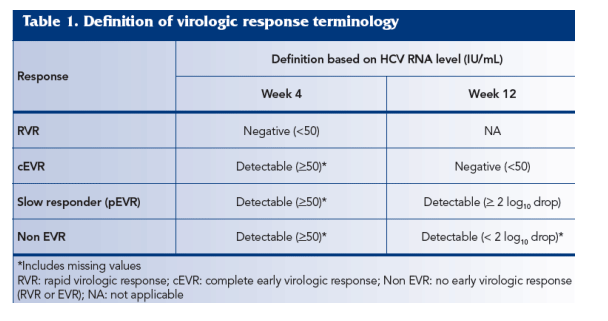
RESULTS
A total of 569 HCV genotype 1 patients were included in this retrospective analysis.
The proportion of patients with an RVR (16%), complete EVR (42%), who were slow responders (23%) and no EVR (19%) are illustrated in Figure 1. The baseline characteristics of the patients in these different response categories are presented in Table 2.
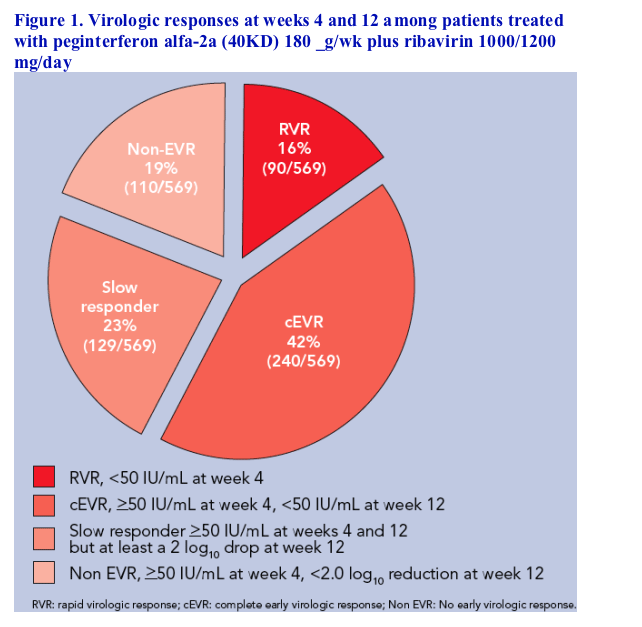
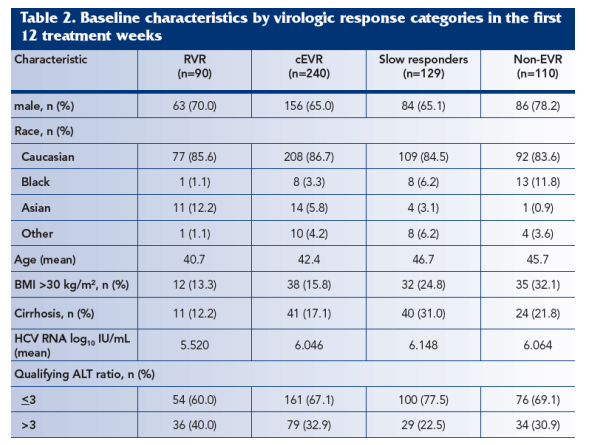
A number of baseline characteristics appeared to be related to the rapidity of the on-treatment virologic responses (Table 2).
-- Black patients were more likely to achieve a slow response or no early response whereas Asian patients were more likely to achieve a faster response.
-- Compared to the sub-groups of patients with an RVR, patients with slower early responses tended to be older, with a high proportion of patients having a BMI >30 kg/m2 and a histologic diagnosis of cirrhosis.
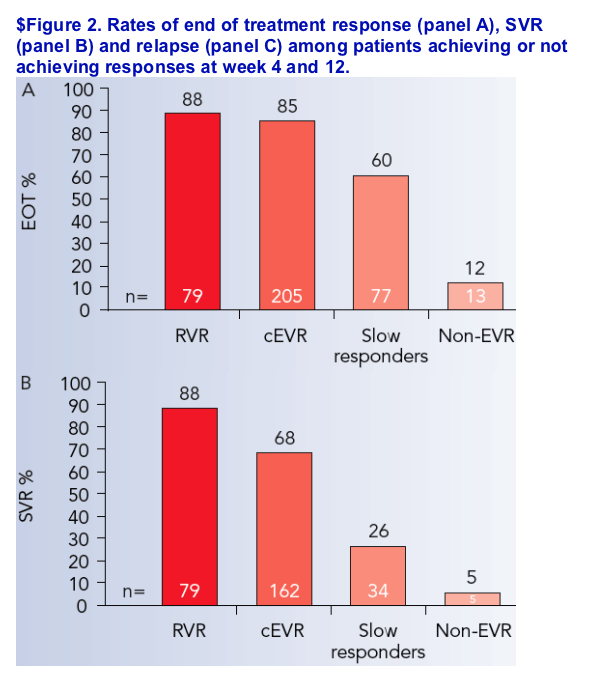
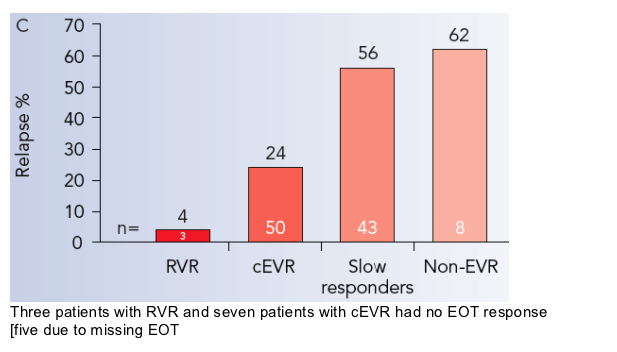
Three patients with RVR and seven patients with cEVR had no EOT response [five due to missing EOT
The highest rates of end of treatment (EOT) response are observed among patients who achieved an RVR (88%), and a cEVR (85%), with rates decreasing among patients with less rapid virologic responses: 60% among patients with a slow virologic response and 12% among those who do not achieve an RVR/EVR (Figure 2A).
The rate of SVR was highest among patients with an RVR (88%) and decreased progressively among patients with less rapid virologic responses by week 12: 68% among those with cEVR, 26% among those with a slow response and 5% among those without an RVR/EVR (Figure 2B).
The rate of relapse was highest among patients without an EVR (62%) and decreased the faster patients responded to treatment. Relapse rates were: 56% among those who were slow responders (pEVR), 24% in those with a cEVR and only 4% among patients who achieved an RVR (Figure 2C).
REFERENCES
1. Jensen DM, Morgan TR, Marcellin P, et al. Early identification of HCV genotype one patients responding to 24 weeks peginterferon alpha-2a (40 KD)/ribavirin therapy. Hepatology 2006; 43(5): 954-60.
2. Shiffman ML, Suter F, Bacon BR, et al. Peginterferon alfa-2a and ribavirin for 16 or 24 weeks in HCV genotype 2 or 3. N Engl J Med 2007; 357(2): 124-34.
3. Marcellin P, Jensen D, Hadziyannis SJ, Ferenci, P. Differentiation of early virologic response (EVR) into RVR, complete EVR (cEVR) and partial EVR (pEVR) allows for a more precise prediction of SVR in HCV genotype 1 patients treated with peginterferon alfa-2a (40KD) (PEGASYS) and ribavirin (COPEGUS). Hepatology
2007; 46 (Suppl 1): Abstract 1308.
4. Fried MW, Shiffman ML, Reddy KR, et al. Peginterferon alfa-2a plus ribavirin for chronic hepatitis C virus infection. N Engl J Med 2002; 347(13): 975-82.
5. Hadziyannis SJ, Sette H, Jr., Morgan TR, et al. Peginterferon-alpha2a and ribavirin combination therapy in chronic hepatitis C: a randomized study of treatment duration and ribavirin dose. Ann Intern Med 2004; 140(5): 346-55.
6. Fried MW, Jensen DM, et al. Improved outcomes among patients with hepatitis C with difficult-to-treat characteristics: Randomized study of higher doses of peginterferon alpha-2a and ribavirin. Hepatology 2008 Jun 9 (ahead of print).
7. Sanchez-Tapias JM, Diago M, Escartin P, et al. Peginterferon-alfa2a plus ribavirin for 48 versus 72 weeks in patients with detectable hepatitis C virus RNA at week 4 of treatment. Gastroenterology 2006; 131(2): 451-60.
|
| |
|
 |
 |
|
|